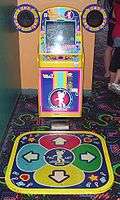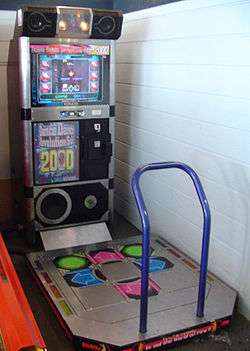Dance Dance Revolution Solo
| Dance Dance Revolution Solo | |
|---|---|
|
Dance Dance Revolution Solo 2000 arcade machine | |
| Genres | Music, Exercise |
| Developers | Konami |
| Publishers | Konami |
| Platform of origin | Arcade |
| First release |
Dance Dance Revolution Solo Bass Mix August 19, 1999 |
| Latest release |
Dance Dance Revolution Solo 4thMix Plus December 28, 2000 |
Dance Dance Revolution Solo was a short-lived series of games spun off of the main Dance Dance Revolution series. It consists of three arcade releases in Japan. The game mode was also adapted for use in a children's arcade version and two console releases (as a game mode).
Gameplay
Gameplay in the Solo series is nearly identical to that of the main Dance Dance Revolution series, but with a few differences to optimize the game for single-player mode. In addition to the four-panel mode offered in the main series, Solo adds a three-panel mode in its Bass Mix and 2000 releases, as well as a six-panel mode in all of its releases. Both modes add two new panels: up-left and up-right. The three-panel mode adds the down arrow to these, while the six-panel mode combines both the four traditional panels and the two new panels.
Games

Main series
Dance Dance Revolution Solo Bass Mix
(ダンスダンスレボリューションソロベースミックス Dansu Dansu Reboryūshon Soro Bēsu Mikkusu) is the first game in the series. It was released as an arcade game by Konami on August 19, 1999 in Japan. The game premiered 16 songs to the series and takes its name, as well as most of its soundtrack, from the Dancemania BASS albums. This is the first game that features a live-action intro.
Dance Dance Revolution Solo 2000
(ダンスダンスレボリューションソロ2000, Dansu Dansu Reboryūshonsoro Tsū Sauzando) the second game in the series. It was released as an arcade game by Konami on December 16, 1999 in Japan. DDR Solo 2000 premiered 20 songs to the series and also featured all 16 songs from Bass Mix, for a total of 36 songs.
Dance Dance Revolution Solo 4thMix
This game and Dance Dance Revolution Solo 4thMix Plus were released concurrently with 4thMix and 4thMix Plus respectively, designed for use with Solo cabinets. The changes in the actual game engine are few, but significant. The 4 and 6-panel modes are offered instead of the usual options, and the chubby arrows of the Solo series also appear. Multi-player Mode from the Solo series is not present in either game.
Derivatives
While not Solo releases per se, these games offer a one-player mode inspired by Solo.
- Dance Dance Revolution Extra Mix for the PlayStation in Japan featured a total of 50 songs: 33 of the 36 songs from Solo 2000, plus 11 songs that premiered in 4thMix Plus, four previews from 5thMix and two songs that later premiered in DDRMAX 6thMix. Of these, only the Solo 2000 and 4thMix Plus songs include Solo steps, though Edit Mode allows players to create custom Solo steps for any of the 50 songs.
- Dance Dance Revolution Konamix for the PlayStation was the only release in North America to feature a Solo mode.
Dance Dance Revolution Kids
(ダンスダンスレボリューションキッズ Dansu Dansu Reboryūshon Kizzu), sometimes abbreviated as DDR Kids (DDRキッズ Dī Dī Ā Kizzu), is a game in the Dance Dance Revolution series aimed at a younger audience. Released in December 2000 by Konami for the Japanese arcade rooms,[1] DDR Kids is limited in comparison to the main series. Only one player can play at a time, the steps are very simplistic and it's easier to score a passing grade. The arcade machine is smaller than a typical DDR machine, designed for smaller players. The song selection is also limited with only a couple of tracks from the main series. The rest are mostly exclusive to this release and feature theme songs to children's shows that have aired in Japan.
Music
All songs from Dance Dance Revolution Solo BASSMIX can also be played in Dance Dance Revolution Solo 2000.
Dance Dance Revolution Kids
- アンパンマンマーチ (♪)
- ウルトラマンガイア (♪)
- おどるポンポコリン (♪♪)
- ターゲット~赤い衝撃~(♪♪♪)
- ダメダメのうた (♪♪)
- プラチナ (♪♪♪♪)
- めざせ! ポケモンマスター (♪)
- SHAKE (♪♪♪♪)
- 全部抱きしめて (♪♪)
- LOVEマシーン (♪♪♪)
- WAになっておどろう (♪♪)
Dance Dance Revolution Solo BASSMIX
- CLUB TROPICANA
- DON'T CLOCK ME
- FREAKY
- GET OFF
- GET UP'N MOVE
- I'M ALIVE
- KUNG FU FIGHTING (MIAMI BOOTY MIX)
- Let the beat hit em!
- LOVE MACHINE
- MY BABY MAMA
- SAMBA DE JANEIRO
- THAT'S THE WAY '98
- TOGETHER & FOREVER
- NONSTOP A
- NONSTOP B
- NONSTOP C
- NONSTOP D
- NONSTOP E
- NONSTOP F
Dance Dance Revolution Solo 2000
- DREAM A DREAM (MIAMI BOOTY MIX)
- DRILL INSTRUCTOR (C-Jah Happy Mix)
- HIGH ENERGY (John '00' Fleming Remix)
- I DON'T WANT TO MISS A THING (PLANET LUTION MIX)
- I'M ALIVE
- KISS ME (KCP REMIX)
- Let the beat hit em! (BM IIDX version)
- SKY HIGH
- STRUT YOUR FUNKY STUFF
- TEMPLE OF LOVE
- TOGETHER & FOREVER
- TYPICAL TROPICAL
- NONSTOP G (Dynamite Rave, Celebrate Nite, Can't Stop Fallin' In Love)
- NONSTOP H (think ya better D, TRIP MACHINE ~luv mix~, LOVE THIS FEELIN')
- NONSTOP I (AFRONOVA, WILD RUSH, DROP OUT)
Soundtrack
A combined soundtrack for both DDR Solo mixes was released by Toshiba-EMI under their Dancemania dance music brand. It contains 35 tracks from the game and all 9 megamixes.
Controversy
In 2002, a local arcade in San Diego, California removed a Solo 2000 machine after Jennifer Stoefen and several members of the local "Youth Advocacy Coalition" complained that the background movies of selected songs contained images that could promote drug and alcohol abuse, such as a scantily clad nurse and pills in "I'm Alive" and alcoholic drinks appearing in "Club Tropicana". The machine was replaced by a mix which did not contain the imagery.[2]
See also
- Dance Dance Revolution
- Oha Suta Dance Dance Revolution, also designed for kids
References
- ↑ "KONAMI GSAN1基板情報(DanceDanceRevolution Kids)" (in Japanese). Retrieved May 13, 2012.
- ↑ "Teens get mad over video; it's removed". Retrieved 2008-01-20.
